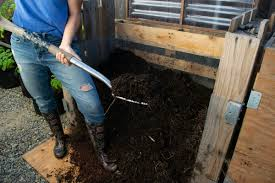Winter doesn’t mean the end of composting. While snow and freezing temperatures may slow things down, composting is still an ongoing process. Even in cold weather, we continue to generate kitchen waste that can transform into valuable compost. Here’s how you can manage your composting routine during the winter months.
Dealing with Kitchen Waste in Cold Weather
Composting in winter can be challenging, especially when icy conditions make it difficult to reach your compost pile. During snowy days, trekking through the cold to dump food scraps onto frozen piles doesn’t provide the same satisfaction as warmer months. To minimize the number of trips to the compost heap, I use a simple method: I place a basic garbage can near my deck. This serves as a temporary holding place for kitchen waste. Even if the waste freezes, it doesn’t smell and remains dormant until spring when the weather warms up. As the freeze lifts, I mix the material into my compost or add it directly to the pile.

How Composting Continues to Work in Winter
Even though the compost pile freezes, the process doesn’t stop entirely. When winter food scraps are added to a stationary composter, the pile freezes and thaws repeatedly, which speeds up decomposition when warmer weather returns. Come spring, the frozen scraps are combined with weathered leaves, and by summer, they break down into rich, dark compost.
Hot Composting in the Winter: Is It Worth It?
Maintaining an actively-heating compost pile during winter can be difficult and impractical. For hot composting to work, the pile must be large enough to generate and retain heat—at least 5 feet tall and wide. Achieving this scale requires an abundant amount of materials and a nitrogen source such as manure, which can be challenging and costly to acquire in winter. If you want to kill weed seeds or tackle specific composting issues, it’s easier to wait until spring. As the weather warms, I mix the nearly finished material with fresh grass clippings and organic fertilizer. Turning this mixture regularly for about three weeks results in a well-composted heap ready for use.

Innovative Ways to Keep Compost Warm
Some gardeners have found creative ways to protect their compost piles from the cold. Insulating the pile with straw bales or bags of leaves helps maintain warmth, and there are even innovators building small greenhouses over compost piles to capture solar heat. While I haven’t used a greenhouse for composting myself, I find the idea fascinating and would love to hear from gardeners who have used greenhouses to boost the composting process during the colder months.
Conclusion
While winter composting comes with its own set of challenges, it doesn’t have to be a completely inactive period. By making simple adjustments, like using a temporary holding bin for kitchen scraps or managing your pile with insulation, you can keep composting throughout the colder months. The process may slow down, but with patience, you’ll have nutrient-rich compost ready by spring or summer.
